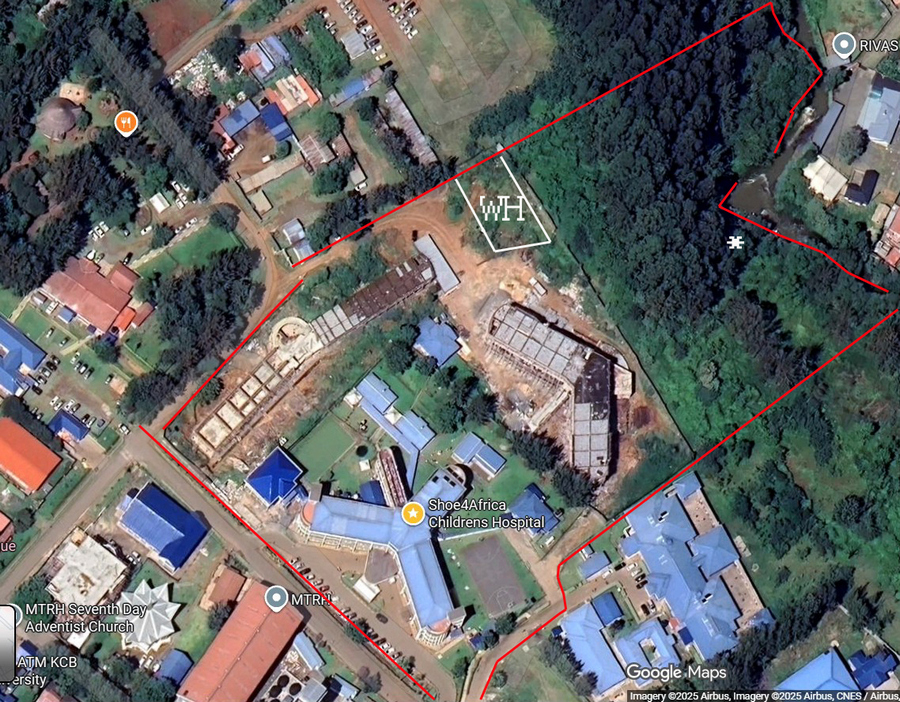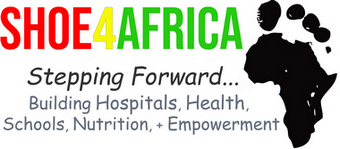
Works in progress…Everyone who spends time at The Shoe4Africa Children’s Health Village – whether they are patients, parents, doctors, medical students, or donors being given a tour – leaves with a profound sense that this is no ordinary center for healing the sick child. Few cities can offer such a large green space of healing smack in the center of the city. But imagine a ‘Disney Land for kids’ with Medical excellence and you’ll start to understand our vision
When a young child approaches a medical center typically you’ll have apprehension and maybe fear. The word hospital is a bit scary. So, our buildings are tapered to lessen the perception of height, colorful child-themed paints are used, and likely that kids upon arrival will hear laughter from the patients playing on our soccer pitch, or our basketball court, or maybe playing on our play station and trampoline. All this interaction starts the healing process even before the child steps into our center.
Since opening our doors, on Aug 12th, 2015, we have treated over 1,300,000 million children, created thousands of jobs and remain the only dedicated public children’s hospital in East & Central Africa.
Why?
Perhaps it’s because the ‘Village’ based around our Shoe4Africa Children’s Hospital will care for around 255,500 patients each year in 2026, most of whom come from exceptionally poor and marginalized communities. Patients are referred to us from not only Western Kenya but also from neighboring African countries. It should be noted that there isn’t a single public children’s hospital in East and Central Africa outside of our facilities. We know by creating a village, with as many medical amenities as possible, we can best serve the Kenyan public.
— KEY FACILITIES AT THE VILLAGE —
1. The Shoe4Africa Children’s Hospital, (opened 2015) LINK
2. The Shoe4Africa Eat n Run Kitchens, (opened in 2017)
3. The Shoe4Africa Lindi House, (outdoor annexed building of play, opened 2017, used by the Child Life Team)
4. The Shoe4Africa Sweden House, (outdoor annexed room opened in 2017*)
7. The Shoe4Africa Basketball Court, opened in 2018
8. The Shoe4Africa Soccer Pitch, opened in 2019
5. The Shoe4Africa Kuunga Mkono Library, opened in 2019
6. The Shoe4Africa Kuunga Mkono Classrooms, opened in 2019
9. The Shoe4Africa Idella Rome Consultant’s House. (opened in 2025)
10. The Shoe4Africa Juli Anne Perry Children’s Cancer Hospital, (planned opening Mar 2026) LINK
11. The MTRH Harry Dyer Burns Unit, (planned opening, Spring 2026)
12. Lion Park concept stage (planning stages).
13. The Shoe4Africa Katie House (Women’s Hostel) (planning stages)
Noted outside the Children’s Village
14. A mosque, a catholic church, a SDA church, and an inter-denominational church.
15. Moi Teaching & Referral Hospital (MTRH) is a Multi-Specialty International Teaching and Referral Hospital serving Kenya, Eastern Uganda, Northern Tanzania, Southern Sudan and the Democratic Republic of Congo with a population of over 25 million. The Shoe4Africa village treats all the children from MTRH.
*This building, 4, was opened as a music/arts therapy room, yet currently being used as a Mother/Child Health clinic for inoculations, nutrition, HIV testing and more.
Those who pass through the doors tell us that the Hospital does far more than treat these patients each year – it embodies the hope of a healthy childhood, the unwavering faith of parents in healing, and the dedication of medical professionals to prevention and cure.
The heart of the center, opened in Eldoret in 2015, the Shoe4Africa Children’s Hospital is the second stand-alone tertiary hospital in sub-Saharan Africa dedicated entirely to child public healthcare, following the Red Cross Children’s Hospital in South Africa, which opened in 1956.
While delivering world-class pediatric treatment and care, we strive to make the greatest impact possible and empower others to do the same. We are a teaching hospital for the Moi University Medical School, providing training to pediatric healthcare professionals. We also conduct groundbreaking research into childhood illnesses that has a global impact.
At The Shoe4Africa Children’s Village, we inspire hope, foster healing, and pave the way for a healthier future for children across Africa.
Concept Plan
The satellite image below provides a snapshot of the site’s layout. As the updated drone photo above illustrates, significant progress has been made since then. The only major project yet to begin construction is the Women’s Hostel (WH), for which fundraising is currently underway, with the goal of breaking ground in 2026.
The asterisk (*) marks a location where we believe a natural underground spring exists. We are currently seeking a grant to develop this spring into a solar-powered water source, with the aim of providing clean, sustainable water not only to our hospital campus but also to the neighboring Moi Teaching and Referral Hospital (MTRH) complex.



